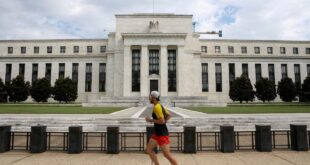PETALING JAYA: Despite the tough global economic conditions, there are prospects which may lift the Malaysian economy in line with the government’s gross domestic product (GDP) projection of 4% to 5% next year.
Economists are generally bullish that the growth drivers will push the economy towards a growth trajectory.
Bank Islam Malaysia Bhd chief economist Firdaos Rosli said the government’s growth forecast for 2024 is justified.
The economy is expected to grow at 5% next year amid base effects, aided by better growth prospects of major and regional economies.
“However, we are on the lookout for signs of external headwinds as interest rates in many global economies will likely remain elevated in 2024.
“Nevertheless, we expect domestic demand to come in higher in 2024 than in 2023.
“As the overnight policy rate (OPR) is likely to remain flat at 3%, this will also give some breathing space for the economy to recalibrate spending at the current interest rate.
“Private consumption will continue to drive growth amid a lower unemployment rate and better wage growth.
“Public consumption, however, may be flat amid the planned subsidy rationalisation next year. The proposed Penang light rail transit project will also boost investments next year as well,” Firdaos told StarBiz.
Juwai IQI global chief economist Shan Saeed
According to Juwai IQI global chief economist Shan Saeed, the economic drivers will be domestic demand, local tourism, Chinese investments in Malaysia and infrastructure investment.
Growth parameters and investments are moving to Asean, Gulf Cooperation Council (GCC) and Africa.
“GDP growth is likely to be between 4.3% and 4.8% in 2024,” he said.
This is premised, among others, on higher oil prices in 2024 and 2025, investment inflows, recovery in China’s economy and inflows of tourist, he added.
KSI Strategic Institute for Asia-Pacific economic adviser Anthony Dass
According to Unitar International University economics professor Anthony Dass, the economy is likely to grow between 4% and 5% next year amid a more broad-based growth.
The resolution of the labour shortage situation could provide additional impetus to growth of laggard sectors like agriculture and construction, he said.
Dass, who is also an economic adviser at KSI Strategic Institute for Asia-Pacific, said: “We expect the labour market to remain robust. Tourism-related activities as well as continuous consumer spending are expected to further spur the growth of the sector.
“Supported by consumer spending and business activities, domestic-oriented industries should grow steadily, backed by higher output in transport and construction-related segments.
“Expectation is for the current electrical and electronics sector downturn to bottom out which would potentially lift exports next year.”
Exports would benefit from the better prospects in global trade as there are increasing expectations of a soft landing for the US economy, leading to possibly a less severe global slowdown.
UCSI University assistant professor in finance Liew Chee Yoong
However, UCSI University Malaysia assistant professor in finance Liew Chee Yoong is projecting GDP to grow at a slower pace of 1% to 2% due to the possibility of the Middle East crisis and Russia-Ukraine war escalating.
One of the growth drivers for the GDP next year would be a more sustained global economic recovery from the recent Covid-19 pandemic.
Meanwhile, OCBC Bank senior Asean economist Lavanya Venkateswaran forecast economic growth at 4.2% next year underpinned by stabilisation in private consumption, modest improvements in investment spending and better export growth.
OCBC Bank senior Asean economist Lavanya Venkateswaran
The external headwinds include “higher for longer” interest rates in the United States, slower-than-expected growth in the United States and China as well as geopolitical risks.
“Domestically, private consumption spending may be negatively affected by the implementation of a targeted fuel subsidy mechanism.
“The government will likely, however, provide cash handouts to lower income households to mitigate some of the impact,” she said.
Although inflation will average at 2.4% next year, it will likely be a story of two halves – low inflation in the first half of 2024 (1H24) but an uptick in 2H24, according to Firdoas.
“We are concerned about the inflationary measures announced in Budget 2024, namely the higher sales and service tax rate and higher selling prices for chicken and eggs that could weigh on the country’s economic growth.
“Subsidy rationalisation also affect inflationary pressure next year as diesel would likely move towards its true market value. Furthermore, should the government initiate a new floating mechanism for RON95, inflation may come in even higher.”
“As the ringgit’s real effective exchange rate is trending at its historic low, imported inflation is a concern when the government pursues subsidy rationalisation,” he said.
The government should maintain macroeconomic stability at the strategic level to attain growth, according to Juwai’s Shan.
He said the government could follow in the footsteps of China which had implemented the dual circulation strategy post-Covid-19.
“The strategic intent is to provide economic confidence to the local investors, entrepreneurs and support domestic consumption for a strong growth outlook,” he noted.
Shan said the government strategy is on the right path – having solid consumption moving along with investment flows in the services, manufacturing, real estate and consumer goods sectors, hence making an economic impact on a macro level.
To ensure the economy remains strong, Liew said the country should maintain a focus on domestic demand, promote foreign and domestic investments and ensure that global trade partnerships are robust.
For the economy to be on a firm footing next year, Dass said there is a need to strengthen its agility in keeping pace with the fast-changing environment.
“The government must embark on a paradigm shift and adopt an innovation culture,” he said.
In addition, all the economic sectors should benefit from the National Energy Transition Roadmap, the New Industrial Master Plan 2030 and the Medium-Term Review of the 12th Malaysia Plan.
“The continuation of strategic projects, digitalisation, improved productivity and advanced manufacturing will further stimulate the growth of the economy in the medium-term.“We will have to be strong, bold and focused to steer towards a new horizon of prosperity and break free from the constraints of the past or risk doing a mere academic exercise that results in stagnant growth and missed opportunities.
“This would help improve the inflows of foreign direct investment (FDI) which in turn will benefit our domestic direct investment (DDI).
“In the first six months of the year, total FDI investment was at RM132bil,” Dass said.
OCBC’s Venkateswaran expects FDI inflows to remain resilient, especially since the government is focused on developing sectors in which the economy already has a strong foundation such as semiconductors and broader electronics.
DDIs will likely be strong with government policies fostering a more conducive environment for investment.
“Juwai IQI expects Malaysia to see investments in technology, logistics and infrastructure. FDI is anticipated to rise by 5% to 10% next year.
“On the domestic front, eCommerce, real estate and oil and gas will remain attractive for local players. The sentiment remained cautiously optimistic for the Malaysian economy,” Shan added.
Liew said environment could be a tough for FDIs next year due to a possible escalation of the Middle East crisis and the Russia-Ukraine war.
“The DDI outlook for Malaysia is expected to be tough as well due to the possibility of the Middle East crisis and the Russia-Ukraine war escalating to become a wider regional conflict next year,” he added.
 BeritaKini.biz Berita Viral Terkini di Malaysia
BeritaKini.biz Berita Viral Terkini di Malaysia





